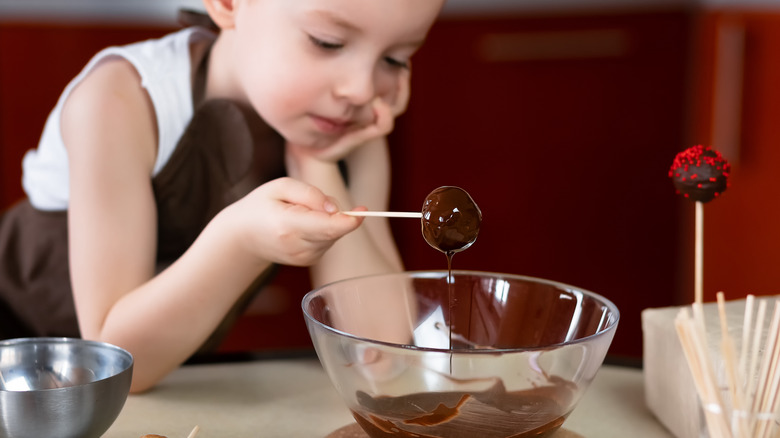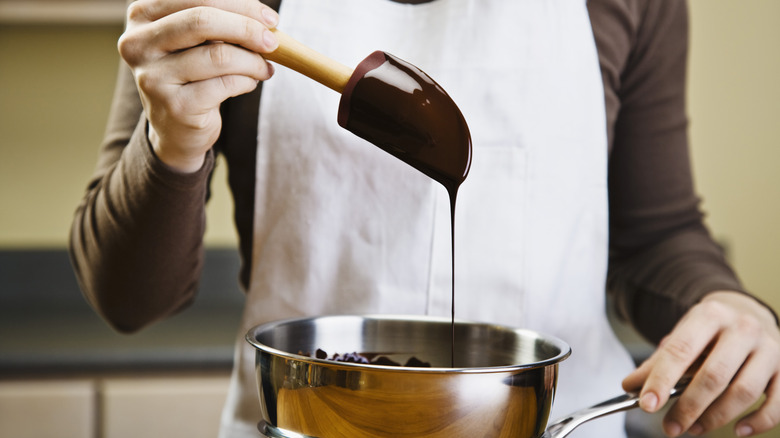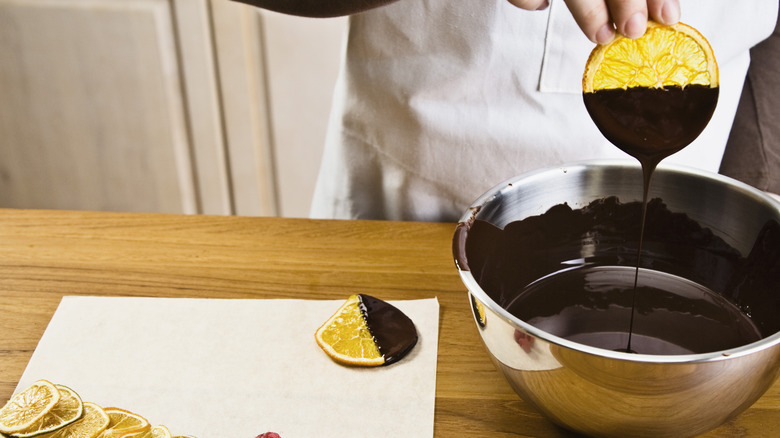The Best Method For Thinning Out Candy Melts
If you're interested in perfecting a cake pop recipe, you've probably used candy melts. These wafer-sized bits of compound chocolate come in lots of different flavors. They're perfect for making confections with a candy coating without having to go through the whole process of tempering chocolate. Just because they're easy to work with doesn't mean that candy melts are totally foolproof, though. There are times when no matter what you do, those candy melts are still too thick. If you're struggling with getting the right consistency with your candy melts, the most important step to getting them properly thinned is to melt them slowly, without overheating.
If you have a bag of candy melts for your next baking project, you can melt them in one of a few ways: over a double boiler on the stove, in bursts in the microwave, or using a candy melting pot. If your candy melts are still too thick while deploying these methods, you can thin them out with a little bit of cooking oil or a teaspoon or two of vegetable shortening. Never, however, try to add water or any other water-based liquid. Doing so will cause your candy melts to seize up and you'll have to start over.
Add some fat to thin things out
Candy melts are not chocolate, so they don't behave quite the same way when they're melted. Candy melts consist of vegetable oil, making them a little easier to work with than chocolate. Chocolate contains cocoa butter instead. Keep this in mind if you need to thin the candy because all you need is a little meltable fat.
If you need to add fat to thin out your candy melts, a good rule of thumb is around 1 and 1/2 teaspoons of vegetable shortening, coconut oil, or other neutral oil per 10 oz. of candy, and around 2 teaspoons of fat for every 12 oz. of candy. Never try to add milk, water, spirits, or anything with water because it will cause the fats in the candy to seize. Also, if you're using a double boiler, be careful to make sure that condensation from the steam in the pot doesn't get into the bowl of melting candy because that will also make the mixture thicken.
Candy melts come in a wide variety of colors but there are times when you might want to make your own custom shades. If you want to alter the color of your melts, don't use water- or gel-based food colorings because even a few drops can cause the candy mixture to seize and thicken. Instead, make your perfect palette using dried food colorings as they won't mess with the oil balance in the candy.
How to properly melt candy melts
Like chocolate, candy melts prefer certain temperature ranges and conditions. If you're melting down a bowl of candy melts, go low and slow. Candy melts work best when they don't go over 90 degrees Fahrenheit. The best way to control the heat is to melt your candy pieces using a double boiler (or a metal bowl over a simmering pot of water). If you want to use a microwave, don't try to melt everything in one go; instead, use small bursts of heat and stir the contents of the bowl in between bursts. If you use candy melts a lot, you can also invest in a candy melting pot that's designed to melt and hold the melted coating at the perfect temperature for dipping. If your candy melts get too hot, they can overcook and seize up, meaning you'll have to start from scratch with fresh candy.
If you're new to working with candy melts, keep a quick-read thermometer on hand to check the temperature of the melting mixture. If you find that even though you've melted your candy properly, things are still a little clumpy, only then should you mix in some fat to loosen the texture.


